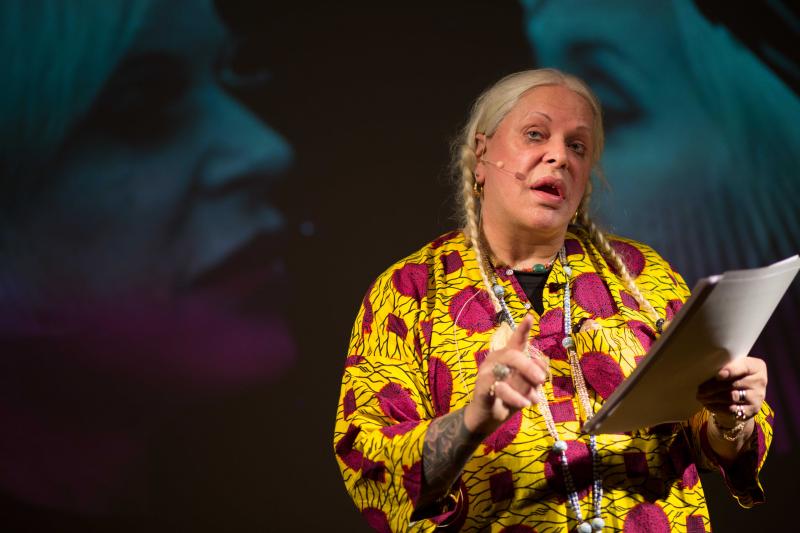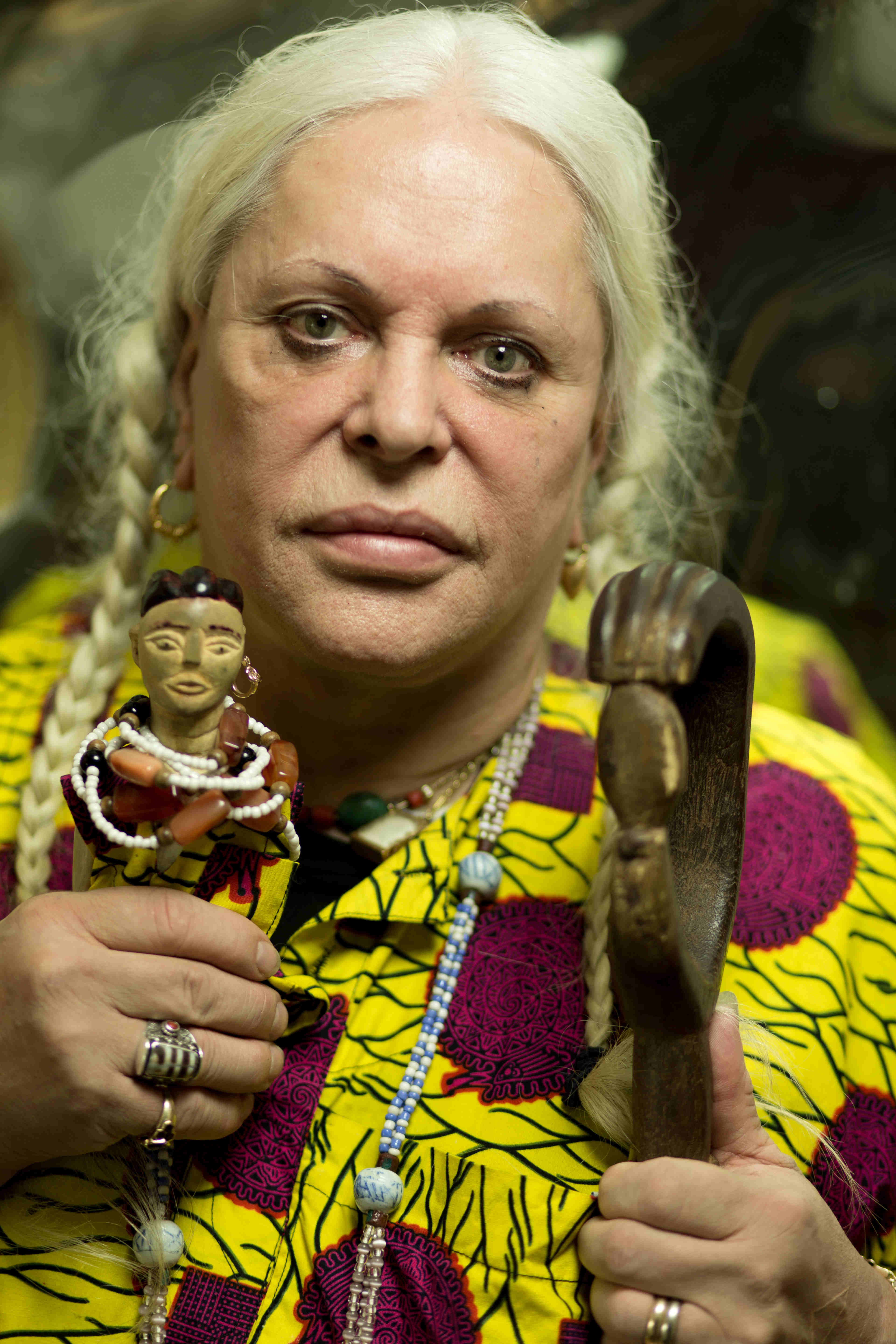Genesis Breyer P-Orridge, October Gallery | reviews, news & interviews
Genesis Breyer P-Orridge, October Gallery
Genesis Breyer P-Orridge, October Gallery
From Throbbing Gristle to pandrogyny: Genesis Breyer P-Orridge reflects

There have been Throbbing Gristle reunions at Tate Modern, and Psychic TV last played in London at the now-demolished Astoria in 2008 – the band in nurse’s uniforms, playing psych garage rock over projections of medical procedures and sex scenes – but it’s a long time since Genesis Breyer P-Orridge was in London.
Combining a sort of spoken-word memoir with poetry and a closing Q&A upstairs at the October Gallery as part of its Burroughs centenary exhibition, Can You All Hear Me?, the first half was an hour’s impromptu talk about how Neil Megson became the pandrogyne figure there on the dias, long grey pigtails framing a surgically altered, heavy-lipped face. He took us through a life’s work in music, performance, visual art and magic, progressing from 1970s communes in Islington and Hull through Industrial music, COUM, Thee Temple ov Psychick Youth, collaborations with William Burroughs and Brion Gysin, raids on his home by Scotland Yard and American shelter and exile under the wing of Winona Ryder’s dad, Michael Horowitz, and his "pandrogyne" life in with Jaye Breyer (who died in 2009), applying Burroughs’s cut-up technique to their own bodies.
 When he first met Burroughs, he tells us, the writer gave him a mission: “Find out how to break the centres of control.” Downstairs in the main gallery, there are artworks by Burroughs – spray paint, shotgun holes – Brion Gysin’s calligraphies, a kinetic Dreammachine-like sculpture by Liliane Lijn, and P-Orridge’s image montages, or Sigils, dating from the 1980s to the 2000s, created with magical intent to affect physical change for friends and collaborators such as Derek Jarman.
When he first met Burroughs, he tells us, the writer gave him a mission: “Find out how to break the centres of control.” Downstairs in the main gallery, there are artworks by Burroughs – spray paint, shotgun holes – Brion Gysin’s calligraphies, a kinetic Dreammachine-like sculpture by Liliane Lijn, and P-Orridge’s image montages, or Sigils, dating from the 1980s to the 2000s, created with magical intent to affect physical change for friends and collaborators such as Derek Jarman.
Upstairs, the sold-out audience listened as P-Orridge cast his nets, unscripted and without faltering, through the shoals of collectivism, magical action, chance operations, physical symbiosis, DNA as virus, non-specific consciousness and cutting the lines of control, of expectation, of physical form. It’s all about opening up to radically altered perspectives and perceptions, and at the heart of it all is the Cut-Up, that most enduring of 20th-century cultural tools. In P-Orridge’s magical universe, it is applied to word, to image, to body, to mind, to gender. It is there in sex magic; that is, in harnessing the power of orgasm to affect actual change. But really, it was about cutting the lines of expectation and therefore control. P-Orridge’s expansive, discursive monologue, sometimes to imagery and projections – including graphic footage of his own cosmetic procedures – and the surprisingly effective poetry with film projections that came in the second half, was an intensive and absorbing application and extension of Burroughs’ methods in the centenary of the writer’s birth.
Other events to accompany the October Gallery's exhibition include a salon of neurologists, botanists, zoologists, biologists and more (January 31) discussing Burroughs’ preoccupations and ideas; and Barry Miles and Stewart Home discussing Cut-Ups as a revolutionary weapon on the last day of the exhibition, February 7.
One of Burroughs’ enduring preoccupations – and one that has inspired at least two feature films – was the occurrence of the number 23. P-Orridge, too, draws on this number and its predilection to appear at significant moments, as a proving of a magical, patterning perception of the universe.
Of course, it goes without saying that this event fell on January 23.
- This event was part of the William S. Burroughs Can You All Hear Me? Exhibition at the October Gallery, which continues until February 7
rating
Explore topics
Share this article
Add comment
The future of Arts Journalism
You can stop theartsdesk.com closing!
We urgently need financing to survive. Our fundraising drive has thus far raised £33,000 but we need to reach £100,000 or we will be forced to close. Please contribute here: https://gofund.me/c3f6033d
And if you can forward this information to anyone who might assist, we’d be grateful.

Subscribe to theartsdesk.com
Thank you for continuing to read our work on theartsdesk.com. For unlimited access to every article in its entirety, including our archive of more than 15,000 pieces, we're asking for £5 per month or £40 per year. We feel it's a very good deal, and hope you do too.
To take a subscription now simply click here.
And if you're looking for that extra gift for a friend or family member, why not treat them to a theartsdesk.com gift subscription?
more New music
 Album: The Waterboys - Life, Death and Dennis Hopper
An alternately involving then naff tribute to a countercultural film figurehead
Album: The Waterboys - Life, Death and Dennis Hopper
An alternately involving then naff tribute to a countercultural film figurehead
 Album: Miki Berenyi Trio - Tripla
Debut set from Lush singer-songwriter’s new trio
Album: Miki Berenyi Trio - Tripla
Debut set from Lush singer-songwriter’s new trio
 Album: Pigs Pigs Pigs Pigs Pigs Pigs Pigs - Death Hilarious
Geordie rockers’ pulverising psych metal is guaranteed to rattle windows
Album: Pigs Pigs Pigs Pigs Pigs Pigs Pigs - Death Hilarious
Geordie rockers’ pulverising psych metal is guaranteed to rattle windows
 Album: Elton John and Brandi Carlile - Who Believes in Angels?
Elton John & Brandi Carlile step out in style
Album: Elton John and Brandi Carlile - Who Believes in Angels?
Elton John & Brandi Carlile step out in style
 Album: Erlend Apneseth - Song Over Støv
Norwegian musical impressionist’s journey into the centre of a vortex
Album: Erlend Apneseth - Song Over Støv
Norwegian musical impressionist’s journey into the centre of a vortex
 Music Reissues Weekly: Yeah Man, It's Bloody Heavy
The ne plus ultra of British heavy rock
Music Reissues Weekly: Yeah Man, It's Bloody Heavy
The ne plus ultra of British heavy rock
 Album: Bryan Ferry and Amelia Barratt - Loose Talk
A match made in urban nightlife and the mysteries of everyday living
Album: Bryan Ferry and Amelia Barratt - Loose Talk
A match made in urban nightlife and the mysteries of everyday living
 Album: Will Smith - Based on a True Story
Big Willie’s back - but maybe he should’ve stayed home
Album: Will Smith - Based on a True Story
Big Willie’s back - but maybe he should’ve stayed home
 Album: Perfume Genius - Glory
Album seven from an artist carving out his own space in the most modernist of ways
Album: Perfume Genius - Glory
Album seven from an artist carving out his own space in the most modernist of ways
 Album: Alison Krauss & Union Station - Arcadia
Their first album in 14 years looks hard at the past, and its role in the present
Album: Alison Krauss & Union Station - Arcadia
Their first album in 14 years looks hard at the past, and its role in the present
 Lauren Mayberry, Barrowland, Glasgow review - solo star stays too close to the day job
The Chvrches singer mixed some great tunes with an overly heavy sound.
Lauren Mayberry, Barrowland, Glasgow review - solo star stays too close to the day job
The Chvrches singer mixed some great tunes with an overly heavy sound.
 Album: Toria Wooff - Toria Wooff
Assured but too measured debut album from Americana-inclined singer-songwriter
Album: Toria Wooff - Toria Wooff
Assured but too measured debut album from Americana-inclined singer-songwriter

Comments
Genesis also spent some time